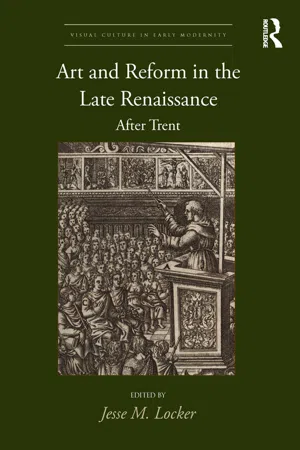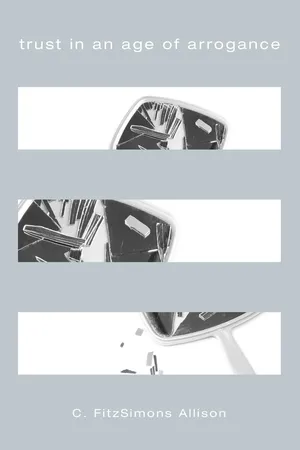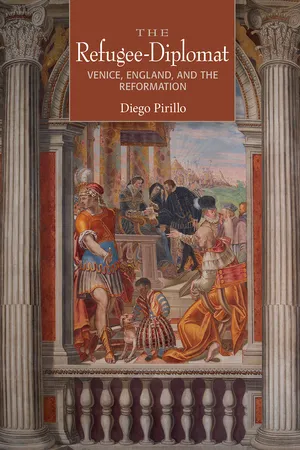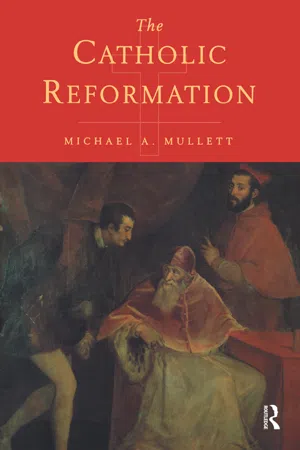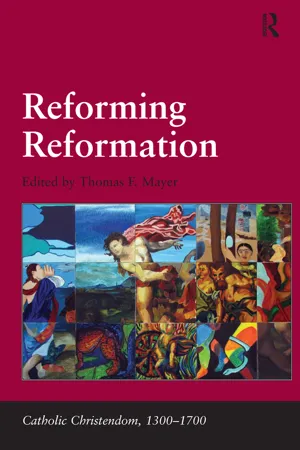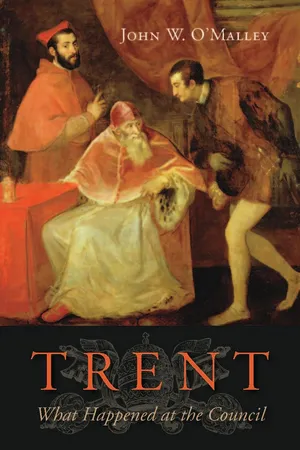History
The Council of Trent
The Council of Trent was a significant ecumenical council of the Catholic Church held between 1545 and 1563. It aimed to address the issues raised by the Protestant Reformation and reaffirm Catholic doctrine. The council made decisions on matters such as the interpretation of scripture, the sacraments, and the role of the clergy, shaping the course of Catholicism for centuries to come.
Written by Perlego with AI-assistance
Related key terms
7 Key excerpts on "The Council of Trent"
- eBook - ePub
Art and Reform in the Late Renaissance
After Trent
- Jesse M. Locker(Author)
- 2018(Publication Date)
- Routledge(Publisher)
Introduction Rethinking Art After The Council of TrentJesse M. LockerThe Council of Trent was convened by Pope Paul III between 1545 and 1563 to defend and clarify Catholic doctrine after decades of Protestant attacks. The impact of Trent on early modern Catholicism cannot be understated. As John O’Malley recently observed, “Anyone with the slightest interest in the cultural and religious history of early modern Europe has heard of [Trent] and been indoctrinated, subtly or not so subtly, into either a positive or a negative assessment.”1 Although images were hardly the most important item on the Council’s agenda, it has nevertheless been considered a crucial turning point in the history of art. But what is the artistic legacy of The Council of Trent? A century ago, this question elicited furious debate among art historians: Did the Council smother artistic creation and lead to a decline in art, stifling expression and effectively halting the Renaissance? Or did it lead to a more “spiritual” art, expressed through abstraction and dematerialization? Or were its ideals only truly realized generations later in the earthy naturalism and ecstatic emotionality of the Baroque? To twenty-first-century art historians, these questions may seem antiquated, a relic of an earlier era preoccupied with categories and labels.But the reality is that there seems to have been a scholarly stalemate that still informs, whether consciously or not, much scholarship on late sixteenth- and seventeenth-century art to this day. When these questions are addressed, it is usually as an after-word on the critical fortunes of the Renaissance or as a prolegomena to the study of Baroque art. The textbook narrative explains how, while initially having a stifling effect on art, by the 1580s and 1590s, encouraged by the spirit of religious reform, Northern Italian painters like Annibale Carracci and Caravaggio, and architects like Giacomo della Porta turned against the artifice and excess of a depleted Mannerism, sought to reinvigorate art by making it more naturalistic, persuasive, emotional, and direct. These reforms, it is argued, made their way to Rome, where artists and theorists from across the Italian peninsula and throughout Europe—Spain, France, the Netherlands—learned from the Italian examples, and brought these lessons back to their home regions and, ultimately, to the New World. Painting and architecture were the first to lead the charge, and only belatedly did sculpture, with the genius of Gian Lorenzo Bernini, successfully take up the agenda of artistic reform. - eBook - ePub
- Richard J. Blackwell(Author)
- 1991(Publication Date)
- University of Notre Dame Press(Publisher)
The primary goal was to restore the unity of Christendom. However, an extraordinarily complex series of religious, political, diplomatic, and military disputes among various European states, with each other and with the popes of the time, postponed the opening of a council for a quarter of a century. 1 As these years passed, the potential for reunification became less and less viable. As a result when The Council of Trent finally did take place (1545–63), the focus had shifted to the goals of clarifying Catholic dogma and reforming the discipline, training, and life-style of the clergy. The eighteen years of the council were interrupted by two lengthy adjournments, first of four years (1547–51), and then of ten years (1552–62). These delays not only further decreased the likelihood of reunification but saw increasing distrust and open hostility between the Catholic and Protestant camps. For the present purposes it is important to emphasize that matters of natural philosophy, or of what we would now call the natural sciences, in no way were of concern in the debates at the council. At best they were mentioned only casually, if at all. The primary thrust of the council can be seen in a brief list of the central topics of decision: the books of Scripture and the role of tradition in the Church, original sin, justification and divine grace, each of the seven sacraments, indulgences, the mass, the education, morals, and preaching duties of the clergy, the jurisdiction and obligation of residence for bishops. These matters clearly centered on doctrinal and disciplinary issues in the life of the Church. However, the decisions arrived at on Scripture and tradition, originally made in response to the challenges of Luther and the other reformers, would later become related to the new ideas introduced by Copernicus - eBook - ePub
- Allison(Author)
- 2010(Publication Date)
- Wipf and Stock(Publisher)
7Roman Catholicism and The Council of Trent
“I confess to almighty God . . . that I have sinned exceedingly in thought, word and deed by my fault, my fault, my very grievous fault.” —Roman Catholic MassR eform of the church in the sixteenth century was by no means an exclusive concern of Protestants. The need for moral, educational, and administrative reform was everywhere acknowledged. The calling and intermittent meeting of The Council of Trent from 1545 to 1563 is a complex story but considerable needed reform was accomplished in training clergy, discipline, renewal of spiritual life, and administration. However, our focus will be on the 5th Session, which dealt with original sin (1546) and the 6th Session, which dealt with justification (1547).No tradition (or generation of believers) is without the need to hear our Lord’s warning concerning the self-righteous yeast of the Pharisees. The decrees of The Council of Trent about sin and justification are to Pharisaism as cigarettes are to cancer. Some issues at these two sessions evoked special criticism from Anglicans and Protestants and dismay among many Catholics as well. Among the latter were Cardinal Seripando, head of the Augustinian order, and Reginald Pole, later the Catholic Archbishop of Canterbury under Queen Mary. Pole was so distressed by the decisions at the 6th Session concerning justification that he left the Council in a state of depression from which it took him many months to recover.1 - eBook - ePub
The Refugee-Diplomat
Venice, England, and the Reformation
- Diego Pirillo(Author)
- 2018(Publication Date)
- Cornell University Press(Publisher)
Pietro Sforza Pallavicino. The rigid control Rome exercised over the history of the council has led scholars to neglect the fact that, in the early modern period, information on Trent nevertheless spread across confessional borders. According to Hubert Jedin, the author of the most comprehensive history of the council, Protestant Europe had only a meager knowledge of what happened in Trent and the leaders of the Reformation were not interested in a council that they considered neither free, nor Christian, nor ecumenical. 3 This chapter reappraises this thesis by revealing how sixteenth-century Italian Protestant refugees leaked information on the council, making it available to Protestant Europe and the Elizabethan court. 4 While the Tudors opposed the council from its beginning and tried to sabotage it by exacerbating the rivalry between the Valois and the Habsburgs, they were also very keen to be informed on Trent. For this reason, the Tudors kept agents and informants in Italy and, through them, gathered information on the Tridentine debates. Their interest in Trent stemmed from the fact that the council was regarded not only as an assembly of prelates dealing with theological matters but first and foremost as a “seismograph” of international politics, through which it was possible to follow the changing relationship between the papacy and the European states. 5 The following pages concentrate on the Italian philo-Protestant Guido Giannetti, who joined Tudor diplomacy in the 1520s, and spent his entire life working as a diplomatic agent for the English court. Though after Henry VIII’s break with Rome Giannetti fled to England, he then moved back to Italy and was employed as an intelligencer in Venice, where he established close ties with the English ambassador and his secretary, Baldassarre Altieri - eBook - ePub
- Michael Mullett(Author)
- 2002(Publication Date)
- Routledge(Publisher)
The papacy was also to provide leadership of the Council once it was assembled through its legates who were, in the first sessions, Cardinals Giovanni Maria Ciocchi del Monte (1487–1555), Marcello Cervini (1501–55) and Reginald Pole. No sooner had the Council gathered, however, than, Christmas intervening, it resolved on its adjournment to 7 January 1546. Upon its resumption, the Council was immediately confronted with the issue of the order of its business, whether doctrinal definition would precede reform of abuses or vice-versa. Pressure for a restatement of traditional doctrine, to be derived principally from the medieval councils and theologians, would run counter to the Habsburgs’ desire to avoid stirring up further doctrinal discord with the Lutherans in Germany and to Charles V’s wish that the Council deal with non-controversial practical reforms, especially in areas of abuse that had boosted Lutheranism’s popularity. In the event, a proposal from Bishop Tommaso Campeggio (c. 1482–1564) that reform and doctrine be taken in alternation, was adopted. The programme of reform was along a familiar track of desiderata for restoring the Church to what was seen as an earlier, purer condition. The agenda of doctrine would be largely a matter of focus on issues that Luther had raised – Scripture, justification and grace, and the Sacraments. 17 Before proceeding further, the Council fathers committed themselves in the Decree Concerning the Manner of Living during the Council, of January 1547, to a frugal, pious and sober way of life at Trent, recalling to us similar resolutions at Pisa in 1511, and anticipating Trent’s delineation of the ideal and scriptural manner of life of a bishop. At the same time, a resolution denounced ‘all false vain and obstinate disputations’, though in point of fact debates in the Council were sometimes to be heated and even violent, because of the vehemence of opposing schools of doctrine present - eBook - ePub
- Thomas F. Mayer(Author)
- 2016(Publication Date)
- Routledge(Publisher)
The field of "early modern Catholicism" was: reoriented such that Rome became the locus of its research, and its research was conducted from a perspective more subtle than Pastor's but which nevertheless echoed it: the successful implementation of Tridentine reforms, once they were promulgated, became the measuring stick of Catholicity, to which was added the recognition of papal primacy in varying degrees. The greatest Catholic historian of the twentieth century, Hubert Jedin, was both largely responsible for this and, in some ways, one of the victims of its development. 51 It was Jedin who wrote the first significant account of Catholic scholarship on the Reformation 52 before going on to produce his justly famous history of The Council of Trent. 53 It was Jedin who summarized and provided the most influential contribution to the debate on the issue '"Catholic Reformation' or 'Counter Reformation'?" How he answered that question is well known: "Both." A Catholic Reformation arose in the fifteenth century that focused on the "self-reform" of the Church's members and that later was given its codification at Trent. In response to the Lutheran heresy a Counter Reformation arose and did battle on doctrinal, political, and military levels. These two reformations are often observable side-by-side, and sometimes independent of one another. 54 The piece is deservedly famous, but neglected is the organizing principle that led him to ask the question in the first place. He concluded the introduction to his essay with a shortlist of four issues he would investigate, the whole point of the exercise being "4. To make these insights useful for an interpretation of The Council of Trent and its place in church history." 55 Jedin's objective was not to arrive at terms and concepts that best captured the reality of early modern Catholicism, but rather to derive terms and concepts that best captured what he considered to be early modern Catholicism's essence, The Council of Trent - eBook - ePub
Trent
What Happened at the Council
- John W. O'Malley(Author)
- 2013(Publication Date)
- Harvard University Press(Publisher)
During the second period, for instance, the pope named two theologians, the emperor seven, Queen Mary of Hungary (the emperor’s sister) eight, the bishops fifteen, the religious orders twenty-two. The overwhelming majority of those named were from the mendicant orders. Before coming to Trent relatively few had direct knowledge of the writings of the Reformers, and far, far fewer could read German. Although the theologians had been trained in dispassionate analysis of texts, they almost without exception read the Reformers with unsympathetic eyes. 15 For reform issues the process, as it developed, was simpler, swifter, less formalized, more varied, and often modified, sometimes drastically. The theologians played no formal part in it. The legates sometimes reserved the draft to themselves, an unpopular procedure with many members of the council. At other times a deputation of bishops with degrees in canon law, known as the Congregation of Canonists, drew up a draft decree, which was then discussed by the bishops in General Congregations. After the initial go-around the draft was remanded back to the legates or canonists for reformulation. When a majority of bishops were satisfied, it was submitted to final and formal vote in a public Session. Here, too, virtual unanimity was the goal. Deputations or committees of various kinds, therefore, played an important role at Trent. Some, as mentioned, formulated drafts of decrees, while others undertook different tasks as occasion warranted. The members were chosen in different ways—sometimes by secret vote of the bishops, more often by nomination by the legates, who then asked for approval from the assembly. Sometimes, however, the legates did not ask—an understandably unpopular procedure
Learn about this page
Index pages curate the most relevant extracts from our library of academic textbooks. They’ve been created using an in-house natural language model (NLM), each adding context and meaning to key research topics.
